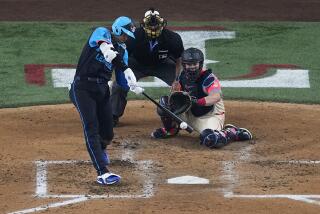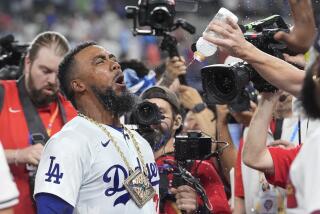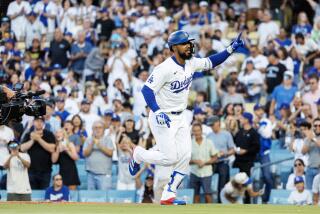Home run derby’s timeless appeal is easily explained: Fans dig the long ball
- Share via
Baseball’s home run derby will be held Monday in front of a nearly full Angel Stadium and a national television audience approaching 10 million.
But it got its start more than half a century ago at a nearly empty Wrigley Field in Los Angeles, a ballpark that used to be located near the intersection of 42nd Place and Avalon Boulevard.
There, greats of another era — Hank Aaron, Willie Mays, Mickey Mantle and others — squared off in a made-only-for-television competition, the original “Home Run Derby.”
Even without a live crowd adding sound and drama to the scene, the show was popular. And ESPN still broadcasts reruns today, giving diehard fans a glimpse of some of the game’s legendary figures from the past.
The allure now is much the same as it was then. Baseball fans, as the old advertising line went, “dig the long ball.”
“It’s the purest part of the sport, just watching someone go out and hit the ball as hard and far as he can,” Steve Brierley, a lifelong baseball fan from Alberta, Canada, said at a recent Dodgers game.
The show developed in 1959 between sportscaster Mark Scott and a broadcasting company. The idea: have the best home-run hitters from each league compete against each other at L.A.’s Wrigley, a hitter-friendly ballpark.
The format called for two players to square off over nine innings, with each getting three outs per inning. Anything but a home run was considered an out. The winner received $2,000, the runner-up $1,000 — and three consecutive home runs earned a $500 bonus.
Scott, handsome and with a baritone voice, moderated the show and interviewed one player while the other batted, giving viewers a personal look at their heroes.
The show was popular but lasted only 26 episodes after Scott, 45, suffered a fatal heart attack in 1960.
As his family eventually found out, he still lives in reruns, though. One December night in 1988, Scott’s widow, Dorothy, said she read in the TV listings that “Home Run Derby” would be playing on ESPN after midnight.
She called her daughter, who had cable.
“Mary Jane, I need you to watch it and see if it’s a new one,” she said.
Mary Jane did, and there was her father.
“I just spent an hour with Dad,” she later told her mother. “It was the original ‘Home Run Derby.’ ”
The network at first used the reruns as late-night filler but has since bumped the show up into daytime slots, evidence that the allure of the home run is timeless.
“Everyone’s fascinated with power,” Angels center fielder Torii Hunter said. “A lot of people can dunk that can’t even play basketball. A lot of people can throw a football, catch a football. But to hit a baseball, and to hit it out of the park, not everybody can do that.”
The draw of the home run — fans are said to be paying $150 to $850 a ticket for Monday’s event on the secondary market — hasn’t waned even as baseball’s dirty laundry was aired in the 2007 Mitchell Report, which identified some of the game’s stars as users of performance-enhancing drugs.
“We want our larger-than-life figures to accomplish greater-than-life accomplishments,” said Bruce Svare, a psychology professor at the State University of New York at Albany who has studied steroid use among athletes. “That’s what our culture is all about. That’s what it’s built upon.”
The biggest threat to the All-Star home run derby is wariness among the players, with several recent participants expressing concern their swings were thrown out of whack by the competition.
There is anecdotal evidence that those fears might be justified.
Playing for the Angels in 2003, Garret Anderson hit 22 home runs in the first half but only six after taking part in that year’s derby. The year before, Hunter, then playing for the Minnesota Twins, hit 20 in the first half, nine thereafter.
“It got me,” Hunter said. “I did not have a good second half, and I’m a second-half player.”
Angels outfielder Bobby Abreu slugged 18 home runs for Philadelphia in the first half of 2005, won the derby with 41 homers, then had only six the rest of the way.
Why, he doesn’t know. “You want to do it at least one time,” he said of the competition. “Then you’re through with it.”
But even the players who wouldn’t do it again admire the players who do.
“You want to be part of the show,” Abreu said.
Added Hunter: “We were fans at one point too.”
Mary Jane Dante certainly still is. She has a frame around her license plate that reads “I love Home Run Derby” and the plate itself states: “HMRNDBY.”
She said people still stop her at red lights to tell her they remember the old show, that they love it, and that they will be watching the new All-Star version.
She watches the new one too because sometimes, as part of the telecast, they run clips from the old show and she can spend time with her dad again.
“It’s just so great to turn on the TV,” she said, “just like that very first night, and there he is.”
More to Read
Go beyond the scoreboard
Get the latest on L.A.'s teams in the daily Sports Report newsletter.
You may occasionally receive promotional content from the Los Angeles Times.










